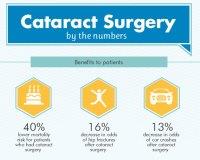Evaluating Cataract Surgical Treatment Alternatives? Check Out The Differences Between Traditional And Laser Techniques To Reveal The Vital Elements That Will Affect Your Vision
Evaluating Cataract Surgical Treatment Alternatives? Check Out The Differences Between Traditional And Laser Techniques To Reveal The Vital Elements That Will Affect Your Vision
Blog Article
Web Content Writer-Bay Kure
When pondering the selection in between traditional cataract surgical treatment and laser-assisted methods, you might find yourself considering the advantages and disadvantages each method uses. The choice goes beyond the surface degree of cost and precision, diving into the world of long-term outcomes and client complete satisfaction. As you navigate with the complexities of these two strategies, it becomes imperative to comprehend the nuanced details that can substantially impact your aesthetic clearness and general experience. Stay tuned to uncover the critical elements that will certainly lead your decision-making procedure in this critical element of eye care.
Traditional Cataract Surgical Procedure Advantages And Disadvantages
When taking into consideration traditional cataract surgery, you might find that it's a reputable and widely-used strategy. In this procedure, a specialist makes a tiny incision in the eye and utilizes ultrasound to break up the cloudy lens before removing it. As soon as the cataract is gotten rid of, a fabricated lens is inserted to recover clear vision.
One of the major advantages of typical cataract surgery is its record of success. Lots of individuals have had their vision substantially improved with this treatment. In addition, standard surgical treatment is often covered by insurance policy, making it a more easily accessible choice for numerous people.
Nevertheless, there are some disadvantages to conventional cataract surgical treatment as well. Recuperation time can be longer compared to more recent methods, and there's a somewhat higher risk of complications such as infection or swelling. Some people might also experience astigmatism or call for analysis glasses post-surgery.
Laser-Assisted Techniques Pros and Cons
Discovering laser-assisted methods for cataract surgery unveils a modern-day strategy that utilizes laser technology to execute key steps in the procedure. One of the key benefits of laser-assisted cataract surgical procedure is its precision. The laser enables very exact lacerations, which can bring about much better visual end results. In addition, the use of lasers can decrease the quantity of ultrasound energy required throughout the surgical procedure, possibly lowering the risk of complications such as corneal damage.
On the disadvantage, laser-assisted techniques can be much more costly contrasted to traditional techniques. This expense mightn't be covered by insurance policy, making it less obtainable to some patients.
An additional consideration is that not all cataract specialists are trained in laser technology, which could restrict your choices for selecting a surgeon.
Finally, while the laser can automate certain facets of the procedure, the surgical treatment still calls for a proficient cosmetic surgeon to ensure effective outcomes.
Comparative Evaluation of Both Techniques
For a thorough understanding of cataract surgery strategies, it's vital to perform a relative analysis of both standard and laser-assisted methods.
Typical cataract surgery entails manual incisions and using portable tools to separate and get rid of the cloudy lens.
On https://www.verywellhealth.com/ativan-lorazepam-drug-information-4016973 , laser-assisted cataract surgical procedure uses innovative technology to produce accurate cuts and break up the cataract with laser power before removing it.
In https://lasereyecost06283.mybuzzblog.com/12026542/are-you-contemplating-lasik-surgical-procedure-however-feeling-hesitant-reveal-the-sequential-process-and-what-lies-in-advance-equipping-you-with-the-understanding-to-browse-this-substantial-vision-improvement-journey of precision, laser-assisted methods provide a higher degree of accuracy compared to traditional techniques. Making use of lasers permits customization of the procedure based on each individual's eye anatomy, possibly leading to much better aesthetic results.
However, should cataract surgery be done on both eyes -assisted cataract surgical treatment tends to be more costly than conventional surgery, which may restrict availability for some individuals.
While both techniques are effective in restoring vision impaired by cataracts, the choice between typical and laser-assisted techniques frequently relies on variables such as price, accuracy, and private patient requirements.
Consulting with your ophthalmologist can assist establish the most ideal technique for your cataract surgery.
stage 4 cataract surgery , when making a decision in between typical cataract surgical procedure and laser-assisted methods, take into consideration factors like price, accuracy, and private requirements. Traditional surgical treatment provides a proven performance history and insurance protection however might feature longer healing times. Laser-assisted techniques offer higher accuracy and customization yet can be more pricey and not constantly covered by insurance policy. Inevitably, the choice in between both approaches depends upon what is most important to you and your specific situation.
